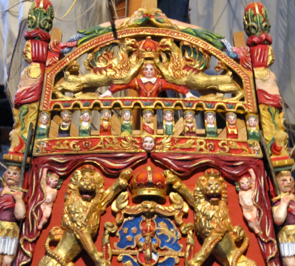Vasamuseet
djurgården
stockholm, Sweden
scandinavia


Vasamuseet
djurgården
stockholm, Sweden
scandinavia


The maritime museum, Vasamusett or Vasa Museum in English is located on the island of Djurgården in Stockholm. The purpose of this museum is to display the almost fully intact 64-gun warship Vasa that sank on her maiden voyage in 1628. The Vasa Museum opened in 1990, and is reportedly the most visited museum in Scandinavia. Together with the Stockholm Maritime Museum, the two fall under the SNMM or Swedish Maritime Museum. The display of this single, deeply carved enormous wooden ship under one roof affords the museum an interesting opportunity to reveal the story of the building, launching, recovery, and restoration of this quite amazing vessel. The museum is dominated by the restored ship, with side exhibitions that explain its entire history. A surprising exhibition regarding the recovery of bodies of people who were drowned when the ship sank, illustrates the amazing field of Osteology, or the study of skeletons. Here, the remains of three people, whose skeletal remains were recovered along with the ship were studied and reconstructed, the head and face literally fleshed out, their hair, costumes, and status revealed, based on the study of their bones. King Gustav II Adolf (1594-1632) was the grandson of Gustav I or Gustav Vasa, the so-called Swedish founder-king, the first of the Vasa Dynasty. The Vasa Family originally had a bundle of sticks as their heraldic symbol (think vase), and it is from this that the Vasa was named. The Vasa’s stern carries a golden sheaf of wheat between two cherubs on the ship’s name board and the initials GARS: Gustavus Adolphus Rex Sveciae, Latin for Gustav Adolf King of Sweden. When Gustav Adolf acceded to the throne in 1611, he inherited three wars: with Russia, Denmark, and Poland. During his reign of 21 years, he was at war 17 of those, not only with wars he had inherited, but also wars he sought. At the same time, Sweden was developing very quickly. Gothenburg was the largest of several new towns established during these years. The country needed to be organized and the Swedish bureaucracy was born. Gustav Adolf’s cousin, Sigismund, was the king of Poland. He had also been king of Sweden between 1592-99, but was deposed, partly because of his Catholic faith. Many others in Europe thought he was the rightful king, and the conflict between the cousins brought up strong feelings. Gustav Adolf was committed to protecting the Lutheran confession, and his wars in the name of religion, expanded Sweden’s borders and laid the foundations for Sweden as a great power. On Sunday, August 10, 1628, Vasa lay rigged and ready for sea just below the royal palace, Tre Kronor. The king was not present, as he was in Prussia. Ballasts, guns and ammunition were all on board. On the quays and shores along Strömmen, an excited public waited to watch the ship leave Stockholm and celebrate her departure. Over a hundred crewmen were on board, as well as women and children. The crew had permission to take family and guests along for the first part of the passage through the Archipelago For the first few hundred meters, Vasa was warped along the waterfront with cables from the shore. The ship did not begin to sail until she reached what is now Slussen. Sailors climbed the rigging to set four of Vasa’s ten sails. A salute was fired, and Vasa slowly began her maiden voyage. Once Vasa came out from under the lee of Södermalm cliffs, the sails could catch the wind, but the ship heeled over to port, then heeled again, ever farther. Water rushed through the open gun ports and the ship’s fate was decided. Vasa sank, after sailing barely 1300 meters/4,265 feet. The crew threw themselves into the water or clung to the rigging until rescued, but not all managed to save themselves. Eyewitnesses differ on the exact number, but perhaps 30 of the approximately 150 people on board died in the loss. After the ship was raised in 1961, the remains of at least 16 people were found. The question still remains about who is to blame for the sinking of the Vasa. The king, in Prussia, receiving the report of the sinking two weeks after the fact, wrote to the Royal Council in Stockholm that ‘the guilty must be punished’. In a palace inquest that followed, the ship’s lack of stability was the fact of the sinking. The leaders of the inquest believed that the ship was well built but incorrectly proportioned. Whose fault was it? Vice Admiral Klas Fleming had been present before the ship sailed. When the captain demonstrated how easily the ship keeled over by having 30 men run back and forth across the upper deck, the ship was ready to capsize at the quay. The admiral was heard to say that he wished the king were there. King Gustav II Adolf was partly responsible, as he ordered this large ship with so many heavy-calibre cannon, and approved the ship’s dimensions. The Master shipwright, the late Henrick Hybertsson was partly responsible. He was a talented shipbuilder who had delivered several successful ships to the navy, but had too little experience with building ships with two gun decks. Captain Söfring Hansson was ultimately responsible. It would have been safer to sail the ship with the lower gun ports closed, since he knew the ship was unstable. It might have been possible to redistribute the weight in the ship or rebuild it. If the inquest were held today, the captain would probably be responsible.
The fascinating history of the Vasa’s building, sinking and recovery follows:
•1626: Construction of the Vasa began at Skeppsgården Shipyard in Stockholm, employing more that 300 men. The casting of bronze cannons began at the military foundry, also in Stockholm.
•1627: Master shipwright Henrik Hybertsson died, succeed by Hein Jacobsson. The ship is launched.
•1628: King Gustav Adof visited Skeppsgården to inspect Vasa. On August 10, 1628, the ship commended her maiden voyage, but after sailing only 1300 meters/4,265 feet, the ship heels over and sank in the middle of Stockholm harbor. Captain Söfring Hansson was arrested but released. No one was blamed for the catastrophe in which 180 people died. Attempts to raise the ship began into 1629, but without success.
•1658: Albrecht von Treileben received a permit to salvage the ship.
•1663-1665: Most of Vasa’s cannons were raised by Treileben’s diver, working from a diving bell.
•1840: Naval engineer Anton Ludwig Fanehjelm introduced modern diving dress to Sweden and dives on the wreck of the Vasa.
•1920: The Olschansky Diving & Salvage Comany’s bid to salvage Vasa was turned down.
•1956: Anders Franzén and Per Edvin Fälting relocated Vasa off Beckholmen in September. The first dives were made at 32 meters and the foremast was raised.
•1957: The navy, the National Maritime Museum, and the Neptuned salvage company cooperated in the salvage of the ship. Divers tunneled under the ship and brought up well-preserved sculptures.
•1958: One of the ship’s remaining three cannons was recovered.
•1959: Heavy cables were drawn under the ship and the Neptune used these to lift and move Vasa into shallower water in 18 separate stages.
•1961: The final lift took place on April 24th and Vasa broke the surface again after 333 years of being submerged in the harbor. After the interior was excavated, the ship was moved into the provisional museum, the Wasa Shipyard. The ship went on view to the public in November, seven months after the salvage.
•1962: Conservation began by spraying with PEG began, work that would last for 17 years.
•1963-67: Divers excavated the harbor bottom where the Vasa lay from 1628-1959, 331 years. Hundreds of sculptures, and thousands of other objects were recovered. The excavation concluded with the raising of the ship’s 11.7 meter-long longboat.
•1979: Spraying of the ship with PEG stopped.
•1987: Construction of the new Vasa Musem began
•1988: Vasa made her last voyage from the Wasa Shipyard to the new museum.
•1990: The Vasamuseet was officially opened on June 15 by King Carl XVI Gustav.
•2000: Rainy weather and a large number of visitors lead to widely varying humidity in the ship’s hall in the summer. Acidic salts were observed on objects in the magazine. A groundbreaking international research program was begun, focused on the preservation of Vasa.
•2002: Fifteen copies of original sculptures, painted in their original colors, were displayed in the exhibition “The Power and the Glory”.
•2004: A new climate system was installed in the Vasa Museum to stabilize the temperature and humidity to preserve the ship.
PHOTOS: Top Three: 1. Vasa Museum’s display of a map of Scandinavia showing the power and placement of the country’s navy in the 17th century. A colorful armored guard is a copy of one of the colorful sculptures that decorated the ship. 2. A diorama in the museum illustrating the sinking of the Vasa on August 10, 1628. 3. A painted scale model of the Vasa in the original colors of the ship. Middle Three: 1. Lifesized diorama in the museum: King Gustav II Adolf visiting the nearly completed ship, Vasa. The shipwright’s widow, Margaret Nilsdotter and her partner, Arendt de Groot, greeted him. 2. One of 15 copies of the original sculptures, painted in the original colors on display in the museum. 3. View of the restored Vasa on the floor that represented the waterline. This view reveals the height of the top-heavy vessel that had a draught of 16 feet. Bottom Two: 1. Painting by Rembrandt von Rijn, The Master Shipbuilder and His Wife, 1633. The original painting is in the collection of Her Majesty HRH Queen Elizabeth II of Great Britain. A photo copy of this painting is illustrated in the Vasa Museet. 2. Detail of the stern of he ship as seen on a painted partial-scale model at the museum. The colorful sculpture included gilt details.

Restored 17th Century Ship Museum







